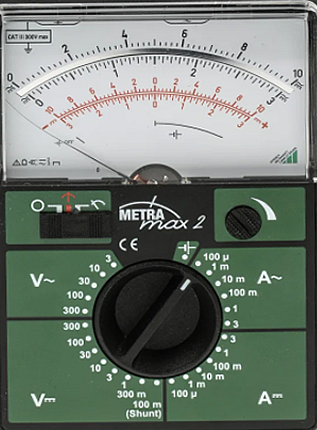 sing an Analogue Multimeter
sing an Analogue Multimeter

An analogue meter reading is made from a needle moving along a scale.
Switched range analogue
multimeters are very cheap but are difficult for beginners to read accurately,
especially on resistance scales. The meter movement is delicate and dropping the
meter is likely to damage it!
Each type of meter has its advantages and disadvantages.
Used as a voltmeter, a digital meter is usually better because its resistance is much higher, 1 MΩ or 10 MΩ, compared to 200 kΩ for a analogue multimeter
on a similar range. On the other hand, it is easier to follow a slowly changing
voltage by watching the needle on an anlaogue display.
Used as an ammeter, an analogue multimeter has a very low resistance and is
very sensitive, with scales down to 50 µA. More expensive digital
multimeters can equal or better this performance.
Most modern multimeters are digital and traditional analogue types are
destined to become obsolete.
 Much of the information and some of the images in this topic were taken from doctronics.co.uk - a brilliant, now defunct site that I used to direct my students towards. I have been unable to find out what happened to this site - but gladly I had saved some of the information for use in my lessons... and I now share them with you!
Much of the information and some of the images in this topic were taken from doctronics.co.uk - a brilliant, now defunct site that I used to direct my students towards. I have been unable to find out what happened to this site - but gladly I had saved some of the information for use in my lessons... and I now share them with you!
